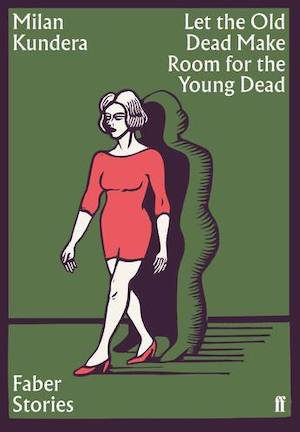Fiction – paperback; Faber & Faber; 44 pages; 2019. Translated from the Czech by Suzanne Rappaport.
French-Czech writer Milan Kundera (1929-2023) penned the short story Let the Old Dead Make Room for the Young Dead in 1969. It appeared in English for the first time in 1974 — in Kundera’s short story collection Laughable Loves — and was reissued by Faber as part of its Faber Stories series to mark the publisher’s 90th birthday in 2019.
It tells the story of a man who bumps into his former lover, a woman much older than him whom he has not seen in 15 years. “I wouldn’t have recognised you,” he apologises.
‘Have I changed so much?’ she asked, and he replied that she hadn’t, and even if this was a lie it wasn’t an out-and-out lie, because that gentle smile (expressing demurely and restrainedly a capacity for some sort of eternal enthusiasm) emerged from the distance of many years quite unchanged, and it confused him: it evoked for him so distinctly the former appearance of this woman that he had to make a definite effort to disregard it and to see her as she was now: she was almost an old woman. (page 2)
With nothing to do but wait for a train to take her back to Prague that evening, she accepts his unprompted invitation to go to his apartment for a coffee instead of waiting in a dirty local cafe.
The story charts the ensuing intimate encounter, fleshes out their backstories, and hints at what has happened in the intervening years in which they have not seen each other. It uses a third-person voice but alternates between the man’s and the woman’s points of view.
Passage of time
The man has recently turned 35 and is beginning to realise he has wasted his youth. He has noticed his hair is thinning on top — “the bald spot wasn’t there yet, but its appearance was quite conceivable” — and regrets that he hasn’t done more with his life.
His financial situation isn’t great because his seven-year marriage ended in divorce and he’s now paying his former wife “support for a child he was allowed to see once or twice a year”.
His love life is dire because he’s too shy around women.
The woman, now in her 50s, has a son and has been a widow for 10 years. She married her husband, a man much older than her, 25 years earlier and, despite “respecting him wholeheartedly”, carried out many infidelities “about which he either didn’t know or didn’t want to know”.
Her relationship with her son is troublesome — he “subjugated her” — and she’s afraid to go back to Prague to tell him that she’s just found out that her husband’s grave plot has been given up because she neglected to renew the lease (hence the book’s title, that the old dead have made room for the young dead).
The man and woman’s unexpected rendezvous is a chance for both of them to reexamine the past and to maybe rekindle their erotic affair.
Inspired by Chekov
In 1974, American writer Philip Roth penned an introduction to this story (in the aforementioned Laughable Loves collection), calling it Chekovian, “not merely because of its tone, or its concern with the painful and touching consequences of time passing and old selves dying, but because it is so very good”.
“Kundera’s amusement emerges as a kind of detached Chekhovian tenderness in the story about the balding, thirtyish, would-have-been eroticist, who sets about to seduce an ageing woman whose body he expects to find disgusting, a seduction undertaken to revenge himself upon his own stubborn phallic daydreams.” (page 44)
For me, the story is more about society’s different expectations of men and women as seen through the lens of an intimate relationship.
Reflecting on her past, the woman is caught between fulfilling the traditional roles of a wife and mother and her own desires, while the man grapples with societal expectations of showing strength and emotional restraint while exuding masculine virility.
Kundera’s narrative also raises important questions about whether one can ever return to being the person one was (or wished to be) and examines memories, dreams, desires and ageing.
Thank you to Armen, from my old book group in London, who sent this to me years ago. It was the perfect read for my tired brain this week. I’m now keen to read more by Kundera, a writer I’ve long neglected.

